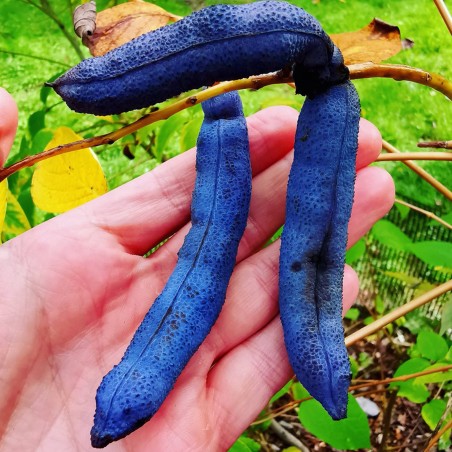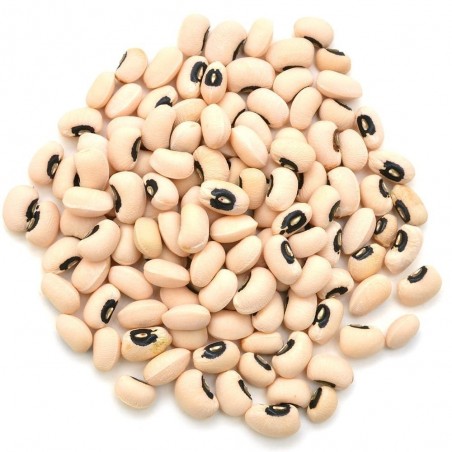
Blue Sausage Seeds Fruit Shrub Decaisnea fargesii
Blue Sausage Seeds Fruit Shrub Decaisnea fargesii
Price for Package of 5 seeds.
Blue Sausage Seeds Fruit Shrub Decaisnea fargesii
Price for Package of 5 seeds.
Dead Man's Fingers, Blue Sausage Fruit, Decaisnea fargesii
Hardy, Easy to Grow, Fast Growth, Showy Ornamental Fruit, Fall Color, Edible Fruits, Attracts Birds, Wildlife Food/Shelter
Decaisnea fargesii or Dead Man's Fingers is an upright, multi-stemmed, deciduous shrub and noted for its showy ornamental edible fruit. Decaisnea belongs to the chocolate vine family and is native from the Himalayas to western China. This shrub typically grows to 20 feet tall and as wide. Theleaves are bright green odd-pinnate, which can be as long as 3 feet, emerging in mid-spring. The flowers are up to 2 inch, bright green-yellow, petal-less, blooming on pendent panicles, up to 18 inches long. Although individual flowers are not particularly showy, the large racemes in bloom are interesting and attractive. Flowers give way to the piece de resistance: cylindrical, bean like seed pods up to 6 inches long that ripen to dull metallic blue in fall. It is these fruits (actually fleshy follicles) that distinguish this plant. The common names of Dead Man's Fingers, Blue Sausage Fruit, Blue Cucumber Shrub and Blue Bean Tree all convey the general message that the fruits are quite interesting and unique. Fruits will split open at maturity to reveal a large mass of seeds imbedded in edible pulp with a sweet taste, but rather insipid. Lepchas (aboriginal inhabitants of Sikkim) relish this fruit, but it is not eaten much outside its native geographic range. Dead Man's Fingers is a surprisingly apt description of what the over-ripe fruit looks, and dare we say, feels like. This is a beautiful plant in its own right, but it really shines as an annual source of excellent Halloween decorations.
This species was discovered by Pere Paul Guillaume Farges (1844-1912) who lived in China and collected and recorded plants there from 1867 until his death. Decaisnea was originally considered to have only two species, D. insignis and D. fargesii, with the only difference between the two being that the former had yellow green fruit and the latter had blue fruit. Today, some experts continue to list two different species (see Royal Horticultural Society), but others have combined both species into D. insignis (see Flora of China).
Other Names: Blue Sausage Fruit Tree, Blue Bean Tree, Dead Man’s Fingers, Decaisnea insignis, Blue Cucumber Shrub
Zone: Winter hardy to USDA Zone 6-9, but may be grown further north into USDA Zone 5 where it may die to the ground in winter with roots surviving to produce new growth in spring.
Growth Rate: Fast
Plant Type: Deciduous shrub or small tree
Family: Lardizabalaceae
Native Range: Western China
Height: 12 to 20 feet
Spread: 12 to 20 feet
Shape: Upright, multi-stemmed
Bloom Time: May - June
Bloom Color: Yellow-green
Flower/Fruit: Yellow-green flowers in drooping racemes followed by exceptional metallic blue bean-like fruit pods.
Sun: Full Sun to Part Shade
Fall Color: Yellow
Drought Tolerance: Low
Water: Medium
Maintenance: Medium
Site Requirements /Soil Tolerances: This shrub is not very hard to grow in cooler temperate climates, in a fertile, well-drained soil and it is quite frost hardy. It is intolerant of drought and hot summer climates. Keep soils consistently moist.
Culture: Best protected from cold winds.
Uses: Best in shrub borders or woodland gardens. Excellent Halloween decorations.
| Sowing Instructions | |
| Propagation: | |
| Pretreat: | soak in water for 24 hours |
| Stratification: | 3 months in moist sowing mix at 2-5 ° C refrigerator |
| Sowing Time: | all year round |
| Sowing Depth: | Cover lightly with the substrate |
| Sowing Mix: | Coir or sowing mix + sand or perlite |
| Germination temperature: | min. 20 ° C |
| Location: | bright + keep constantly moist not wet |
| Germination Time: | until it germinates (2-8 weeks) |
| Watering: | Water regularly during the growing season |
|
|
|
| Organic Seeds ? | Organic Seeds |
|---|---|
| Organic/natural ? | Organic/Natural: Yes |
| Edible ? | Edible |
| Pretreatment of sowing ? | Soak in water before sowing 12-24 h Stratification needed: Yes |
| Life Cycle: | Perennial plant : Yes |
| Handpicked seeds ? | Handpicked seeds |
| Resistant to cold and frost ? | Cold resistant: to −20 °C |
| Suitable for growing in flower pot ? | Suitable for pot: Yes |
| Plant height ? | 10-15 m |


Your review appreciation cannot be sent
Report comment
Report sent
Your report cannot be sent
Write your review
Review sent
Your review cannot be sent
🌍 Worldwide Shipping from the EU
We ship worldwide from the European Union using registered air post with signature confirmation on delivery.
📦 Tracking Your Order
Log in to your account and go to Order History > Details to find your tracking number.
You will receive email notifications at every step — please check your spam/junk folder if you don’t see them.
Track your package via:
⚠️ Important Notices
Cash on delivery is not available.
Always provide a valid mobile number with country code when ordering (e.g., +365 456 7686 576).
Do not order to P.O. Boxes or if you cannot be home to sign for the package. We cannot leave parcels with neighbors.
If a package sent to a P.O. Box is lost or undelivered, you lose the right to a refund.
📦 Lost, Returned & Reshipping Packages
For customers in Brazil and Mexico:
We cannot refund packages lost or destroyed by customs.
If your package is returned, we will refund only the product cost — shipping costs are not refundable.
You must pay return postage (€2) and any costs for reshipping.
If a package is returned to us for any reason, you are responsible for paying the return shipping (€2) plus the cost to resend the package.
🚚 Shipment Delivery
Registered shipments require a signature from the recipient.
If your tracking shows the package is still at the origin post office, it means the package is in transit — please contact your local post office directly for updates.
We are not responsible for delivery times and cannot track shipments for you.
📅 Delivery Options & Estimated Times
Delivery Option Processing Time Notes Priority Delivery Ships in 1-7 business days Prioritizes order processing (not guaranteed faster delivery); delays possible during holidays (3-10 days) Secured Delivery Ships in 1-7 business days Available for orders up to €150; refund if lost Standard Delivery Ships in 7-10 business days More economical; delays possible during holidays (7-14 days) Estimated Delivery Time:
Within the EU: 3–20 days
Worldwide: 5–30 days
Example delivery times to the USA:
Delivered in 13, 17, 19, 22, or 27 days.Note: Delivery times depend on your location and the local postal system. COVID-19 may cause additional delays.
💰 Shipping Costs
Shipping and handling fees are calculated automatically during checkout based on the weight of the parcel and the destination country.
⏰ Order Processing Hours
We do not process or ship orders on Saturdays or Sundays.
💳 Payment Options
Bank Transfer (SEPA / IBAN / SWIFT-BIC)
Include your order reference in the payment description (e.g., "SGS-19811702"). Orders without payment within 7 days are automatically cancelled.PayPal
Payments accepted in Euros only. Please select Euros at checkout.Card Payment
For card payments, visit our other site: Exotic Seeds Store
We accept Visa, MasterCard, American Express, CB, Diners Club, Discover, China UnionPay, JCB, and Discover.
⚠️ Transaction Fees
Customers are responsible for any transaction fees. Please provide payment details to help us process your order efficiently.
📢 Final Notes
Before placing your order, please check our website for any special notices, holiday schedules, or specific conditions that may affect your purchase.
Related Products





















